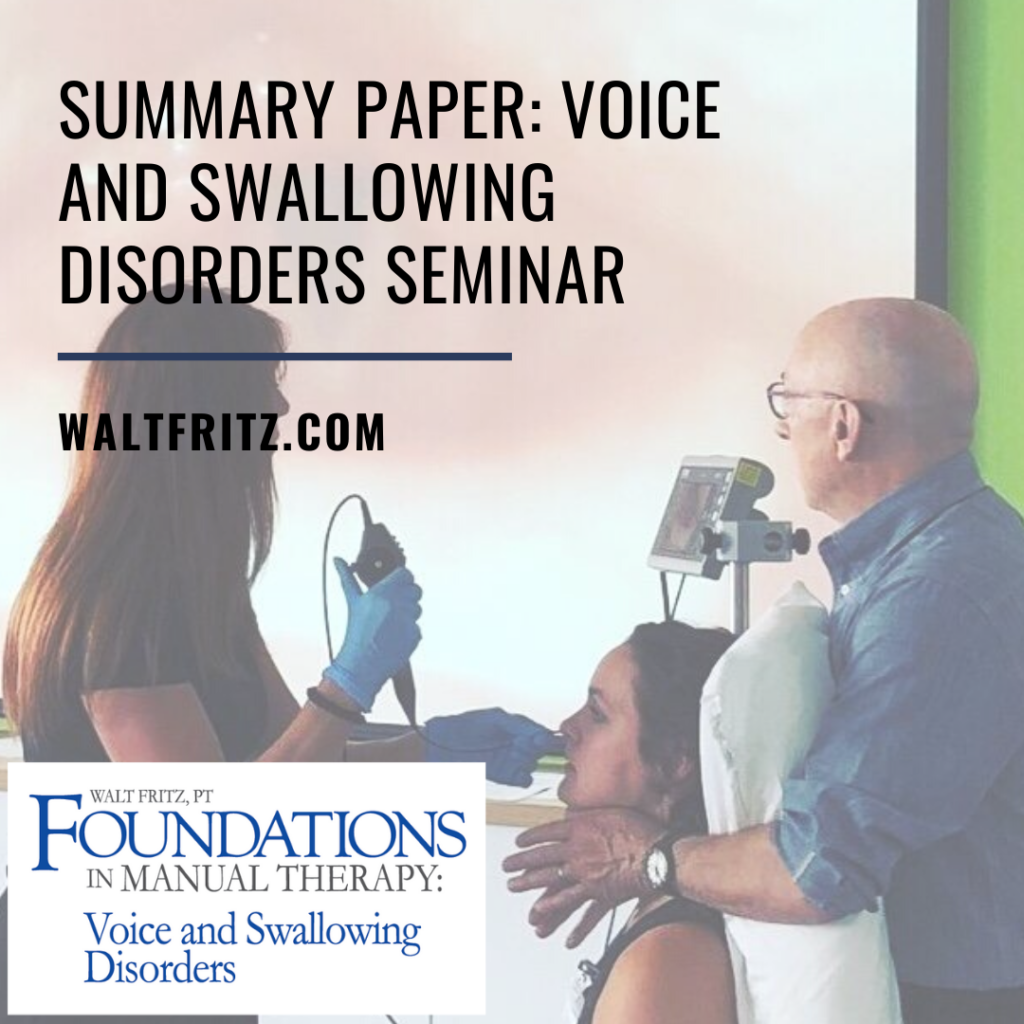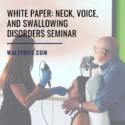
Summary Paper on the Foundations in Manual Therapy: Voice and Swallowing Disorders Seminar
Walt Fritz, PT
In response to inquiries requesting information about the Foundations in Manual Therapy: Voice and Swallowing Disorders Seminar and how manual therapy applies to the field of speech-language pathology (SLP), this summary puts some relevant information all in one place.
Evidence: There is robust evidence to support the use of manual therapy with disorders of voice, swallowing, trismus/TMJ disorder, lingual region, oral-motor and articulation disorders, breathing, pediatric disorders, and many more issues. That evidence also supports concepts of shared decision-making in the therapeutic process, a vital component of this work. Unlike older models of manual therapy and myofascial release used for voice, swallowing, and related disorders that rely solely upon the judgment of the clinician, newer models (including the one presented in the Foundations in Manual Therapy: Voice and Swallowing Disorders courses) utilize multifactorial explanations and allow a patient-centered model of care. Included in the SLP-related literature since 1990, SLPs have increasingly leaned on it to reach into broader patient perspectives.
Course philosophy: Unlike many manual therapy courses, the Voice and Swallowing Seminar is less about teaching you outdated tissue-specific concepts or narrowing down pathology to a single anatomical structure. Instead, the class takes a broad view of the multiple, often overlapping, narratives of impact. This approach at first may seem vague, as single structure/tissue targets are not specified. Still, this approach is explained quite easily by looking at the diversity of explanations clinicians use to describe the effects of manual therapeutic approaches. Instead of pointing to a single tissue, or even pathology, as causative and as the target of intervention, I turn the tables a bit and allow and require the patient to play a more active role in treatment decision-making. We certainly must know the anatomy and physiology of the body areas that we are working on but attempts to specify the causative anatomy are rife with errors.
I believe in a patient-centered approach, keeping with the balance of the three essential components of the evidence-based model of care. While most clinicians value the evidence and their experience applying it, giving patient expectations and values equal weighting is rare. In my courses, I stress the importance of balancing out those inequities. In the historical model, where the clinician is viewed as being the expert, and the patient is the receiver of this wisdom, there are fundamental aspects of the biopsychosocial experiences of the patient that are overlooked. I feel these perspectives are crucial factors in determining the relevance of any intervention and are an essential part of the way I approach this work.
Lastly, many of the terms used to describe the nature of manual therapy protocols, including the terms myofascial release, manual circumlaryngeal treatment, and others, are often spoken of as fact, with evidence to support their tissue/pathology-specific impacts. But when one views the whole work, from peripheral to central, blaming specific tissues, structures, or even pathologies, becomes more unrealistic. This issue is one of the many reasons that my seminars have been rebranded from “myofascial release“ to “manual therapy.” The latter term is a more honest representation of a manner of work (manual therapy) rather than imply ownership over a specific tissue or pathology. Also confusing is the wide variation in styles of work associated with myofascial release, from deep, rather aggressive manipulation of the tissues, to a very light, nearly weightless method of interaction. I fall somewhere in between those extremes and prefer to allow my patient to choose the level of pressures that feel appropriate. This negotiation of pressures is only a part of how I demand feedback and input from every patient, even those who, at first, may not seem capable of such contribution.
Additional resources: I host a YouTube channel (viewable from the “Online Courses and Resources” tab at WaltFritz.com) set up to answer commonly asked questions about the approach that I use. The channel includes a wide range of topics and gives the viewer an opportunity to see this work in action. Also, at the website is a wide range of podcasts I’ve been a part of, many of which are longer, more in-depth interviews. Poke around the website for more information.
Walt Fritz, PT
You can download a shareable version of this article here:


Sorry, comments are closed for this post.